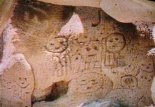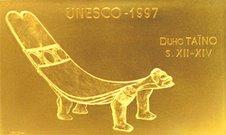By Domingo Hernandez De Jesus
Some critics of the Taino movement were denying any biological inheritance among the contemporary Boricua population. When faced with the now famous DNA studies they defended their position by stating that this Native American contribution could not be attributed to the Taino bloodlines. They argued by reminding us that for two hundred years, Native Americans were brought as slaves from many parts of South, Central and North America, so these and not the Taino may be our ancestors.
It seems to me that they did not read Dr. Juan Martinez Cruzado's full report. He points out that the number of Africans taken to Puerto Rico vastly outnumbered those of the Native American slaves who originated out side of the island. If the biological contribution in question came only from a imported source, then the number of persons with these markers today would be smaller than the African. Therefore it is his conclusion that the majority of the Native American genetic material found in Puerto Rico today comes directly from the Taino population since it surpasses the number of African contribution by 40%. We also know that this DNA study was tracing the female line and records show that the vast majority of slaves were male and their genetic contributions would not show in this particular study.
The devastation of the European invasion was felt in common by all Native American nations. At the time of the first contact our Taino ancestors numbered in the millions. It is interesting to note that many smaller nations managed to escape extinction. The Cherokee were estimated to have about 20,000 at the time on contact. Their numbers were affected by the same conditions. During the Trail of Tears most of the Cherokee were forced to leave their land for far away Oklahoma. Less than 1,000 Cherokees managed to escape the removal and were able to stay in their ancestral lands. Today their descendents are known as the Eastern Cherokee and they have 13,079 enrolled members. Just 48 years before the removal of the Cherokee we find a military census in Puerto Rico that mentions 2,302 Indians living in an area known as "Las Indieras" that same original census also mentions that there was another Indian community of similar size living in Anasco. This census is saying that there were at least 4,000 full blood Native Americans living in Puerto Rico at that time (1778) They were full bloods because the Spanish were fanatical about creating names and categories for those of any amount of mixture (ie. Mestizo,Pardo, Mulato,Trigueno, Jabao, Zambo etc).
These people were clearly listed as Indios. So I wonder why if we had 4,000 full
bloods just 200 years ago, how is it we have none today? Or do we? How could the Eastern Cherokee go from a small group of 1,000 to 13,000 in 200 yrs. while the Taino go from 4,000 to 0 in the same time frame? There is no mention of wars or uprisings as was happening in the USA at the time. So what could account for the Taino's disappearance ?
We look at the 1800 census and those that came afterward the category of Indian has been left out. The numbers under the category of Pardo also show a great increase. The Indians were simply put in another category. This other category “Pardo" has been translated as colored. Many in the USA think of the term of color as being Black. Yet the census form had a different listing for “Free Blacks.” There were also listings for enslaved Blacks and enslaved Mulatos. The term Pardo (brown) was used only for free persons who were considered non Whites and also non Black by Spanish standards. these were the bi-racial and tri-racial combinations of Native American African and European offspring.
To insist that the Taino are extinct is to deny the overwhelming evidence to the contrary.
It is to imply that somehow under the same circumstances and in some cases even better conditions than others, our ancestors were too weak or too dumb to survive when others did. It is to assume that our Taino blood line is thin and faint. That we are claiming one individual who lived 500 years ago. These conclusions are a mistake, and border on racist. The truth is that 200 years ago Native full bloods are documented to be in Puerto Rico that they numbered between 2,000 to 4,000. That these people were in contact with a larger population of Mestizos, Mulatos and Zambos. Most of which by definition had a strong Native component. Add to this the fact that there was a strong level of isolation to many parts of Puerto Rico, not only in the 1800s but even into the mid-20th century.
In the early 1900's there were barely 60 miles of paved roads in all of Puerto Rico. There were many communities that were inaccessible except by mule, horse or by foot. While every official town had their own church, the surrounding villages did not. This is why Puerto Ricans baptize their children twice. Once without a priest and one with. Both of my grandmothers gave birth at home in huts with only a mid-wife to help. My point is that in isolation the blood quantum can stay the same indefinitely, if the persons reproducing have the same quantum. So in communities where you have full bloods, mixing with half bloods and these villages are isolated you will still find many if not most with consistent and strong features reflecting their Indian background. This is the case in a large proportion of our people. This is why so many of us still fit the description given by Colon himself: bronze skin tone, straight black hair, high cheekbones, etc.
Many of our families report that their children are born with the " Mongol Spot" But doctors don't tell them that it is a trait common with Asians and Native Americans , they just tell them it means that the baby will be dark. This spot is what originally was meant by the " Mancha de Platano" (the Plantain Stain) because that is what it tends to look like on our babies. Our Taino bloodlines are not weak or faint, many of us just have to go back two generations to connect with our Taino life ways. In terms of blood we know it is there. We need only give the eye test to ourselves or to some other close relative.
I don't have to claim someone from 500 years ago. I claim my grandfather and both my grandmothers.
 UCTP Liaison Officer Roger Guayakan Hernandez,
UCTP Liaison Officer Roger Guayakan Hernandez,









